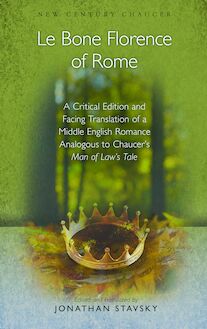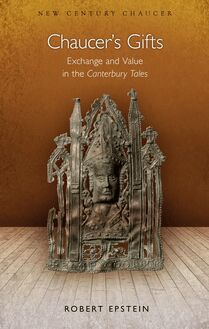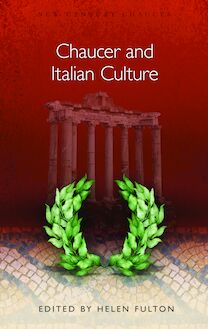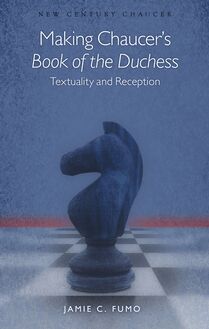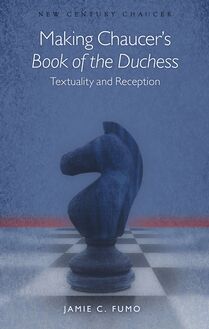-
 Univers
Univers
-
 Ebooks
Ebooks
-
 Livres audio
Livres audio
-
 Presse
Presse
-
 Podcasts
Podcasts
-
 BD
BD
-
 Documents
Documents
-
- Cours
- Révisions
- Ressources pédagogiques
- Sciences de l’éducation
- Manuels scolaires
- Langues
- Travaux de classe
- Annales de BEP
- Etudes supérieures
- Maternelle et primaire
- Fiches de lecture
- Orientation scolaire
- Méthodologie
- Corrigés de devoir
- Annales d’examens et concours
- Annales du bac
- Annales du brevet
- Rapports de stage
La lecture à portée de main
Vous pourrez modifier la taille du texte de cet ouvrage
Découvre YouScribe en t'inscrivant gratuitement
Je m'inscrisDécouvre YouScribe en t'inscrivant gratuitement
Je m'inscrisEn savoir plus
Vous pourrez modifier la taille du texte de cet ouvrage
En savoir plus

Description
Making Chaucer’s Book of the Duchess: Textuality and Reception is the first comprehensive book-length study of Chaucer’s earliest major narrative poem and its reception. It provides a rigorous and critically balanced assimilation of the Book of the Duchess, the story of its reception and dissemination, and the major trends in its interpretive history into the fabric of twenty-first century Chaucer studies.
Focusing on the construction and value of the Book of the Duchess as a book, this study explores Chaucer’s concern with acts of writing and the textual mediation of experience. At the same time, it contextualises Chaucer’s poem within his era’s broader concerns with authority, reading practices, and the vernacular. By yoking issues of creative and scholarly reception with those of book production and materiality, Jamie C. Fumo’s study innovatively highlights acts of collaboration stemming from the poem’s status as a textual, imaginative act.
Introduction
Chapter 1. Reading the Book (I): Critical History — An Overview
Chapter 2. Reading the Book (II): Themes, Problems, Interpretations
Chapter 3. All This Black: Reading and Making
Chapter 4. Rereading the Book (I): The Materials of Transmission
Chapter 5. Rereading the Book (II): Literary Reception Up to the Sixteenth Century
‘Now hit ys doon’: Conclusion
Bibliography
Sujets
Informations
| Publié par | University of Wales Press |
| Date de parution | 24 septembre 2015 |
| Nombre de lectures | 0 |
| EAN13 | 9781783163496 |
| Langue | English |
Informations légales : prix de location à la page 0,1074€. Cette information est donnée uniquement à titre indicatif conformément à la législation en vigueur.
Extrait
NEW CENTURY CHAUCER
Series Editors Professor Helen Fulton, University of Bristol Professor Ruth Evans, Saint Louis University
Editorial Board Professor Ardis Butterfield, Yale University Dr Orietta Da Rold, University of Cambridge Dr David Matthews, University of Manchester
The works of Geoffrey Chaucer are the most-studied literary texts of the Middle Ages, appearing on school and university syllabuses throughout the world. From The Canterbury Tales through the dream visions and philosophical works to Troilus and Criseyde , the translations and short poems, Chaucer’s writing illuminates the fourteenth century and its intellectual traditions. Taken together with the work of his contemporaries and successors in the fifteenth century, the Chaucerian corpus arguably still defines the shape of late-medieval literature.
For twentieth-century scholars and students, the study of Chaucer and the late Middle Ages largely comprised attention to linguistic history, historicism, close reading, biographical empiricism and traditional editorial practice. While all these approaches retain some validity, the new generations of twenty-first-century students and scholars are conversant with the digital humanities and with emerging critical approaches – the ‘affective turn’, new materialisms, the history of the book, sexuality studies, global literatures, and the ‘cognitive turn’. Importantly, today’s readers have been trained in new methodologies of knowledge retrieval and exchange. In the age of instant information combined with multiple sites of authority, the meaning of the texts of Chaucer and his age has to be constantly renegotiated.
The series New Century Chaucer is a direct response to new ways of reading and analysing medieval texts in the twenty-first century. Purpose-built editions and translations of individual texts, accompanied by stimulating studies introducing the latest research ideas, are directed towards contemporary scholars and students whose training and research interests have been shaped by new media and a broad-based curriculum. Our aim is to publish editions, with translations, of Chaucerian and related texts alongside focused studies which bring new theories and approaches into view, including comparative studies, manuscript production, Chaucer’s post-medieval reception, Chaucer’s contemporaries and successors, and the historical context of late-medieval literary production. Where relevant, online support includes images and bibliographies that can be used for teaching and further research.
The further we move into the digital world, the more important the study of medieval literature becomes as an anchor to previous ways of thinking that paved the way for modernity and are still relevant to post-modernity. As the works of Chaucer, his contemporaries and his immediate successors travel into the twenty-first century, New Century Chaucer will provide, we hope, a pathway towards new interpretations and a spur to new readers.
NEW CENTURY CHAUCER
Making Chaucer’s Book of the Duchess
Textuality and Reception
JAMIE C. FUMO
© Jamie C. Fumo, 2015
All rights reserved. No part of this book may be reproduced in any material form (including photocopying or storing it in any medium by electronic means and whether or not transiently or incidentally to some other use of this publication) without the written permission of the copyright owner except in accordance with the provisions of the Copyright, Designs and Patents Act 1988. Applications for the copyright owner’s written permission to reproduce any part of this publication should be addressed to the University of Wales Press, 10 Columbus Walk, Brigantine Place, Cardiff CF10 4UP.
www.uwp.co.uk
British Library Cataloguing-in-Publication Data A catalogue record for this book is available from the British Library.
ISBN 978-1-78316-347-2 eISBN 978-1-78316-349-6
The right of Jamie C. Fumo to be identified as author of this work has been asserted in accordance with sections 77, 78 and 79 of the Copyright, Designs and Patents Act 1988.
Cover design: Olwen Fowler Cover image: wavebreakmedia / shutterstock
To Vincent, for giving the push, and to Rocco, for leading the way
CONTENTS
Acknowledgements
List of Abbreviations
Introduction
1 Reading the Book (I): Critical History – An Overview
2 Reading the Book (II): Themes, Problems, Interpretations
3 All This Black: Reading and Making
4 Rereading the Book (I): The Materials of Transmission
5 Rereading the Book (II): Literary Reception up to the Sixteenth Century
‘Now hit ys doon’: Conclusion
Notes
Bibliography
ACKNOWLEDGEMENTS
C ombing through the entire critical history of even a supposedly ‘minor’ Chaucerian poem is a daunting task for the twenty-first-century scholar, and in this I benefited enormously from several valuable scholarly resources. I must record my debt to the generous and informative interpretative guides to the Book of the Duchess provided in Helen Phillips’s 1982 critical edition and Colin Wilcockson’s Explanatory Notes in The Riverside Chaucer , as well as A. J. Minnis’s overview of the poem and its backgrounds (with V. J. Scattergood and J. J. Smith) in the 1995 Oxford Guides to Chaucer volume on The Shorter Poems , and Will Roger Knedlik’s 1978 University of Washington PhD dissertation on ‘Chaucer’s Book of the Duchess: a bibliographic compendium of the first 600 years’. I am grateful to Stephanie Downes for sharing work in progress on Chaucer’s French reception, and to Ben Barootes for numerous inspiring conversations regarding the Book of the Duchess , the fruits of which appear in a McGill University doctoral dissertation from which I profited in the later stages of this study. I would also like to record my sincere appreciation for the support this project received at University of Wales Press. Finally, my deepest thanks go, as ever, to this study’s dedicatees, without whom there probably would have been no book, and certainly no dream.
LIST OF ABBREVIATIONS ChR Chaucer Review EETS Early English Text Society MED Middle English Dictionary OED Oxford English Dictionary SAC Studies in the Age of Chaucer
Individual works by Chaucer are abbreviated in accordance with The Riverside Chaucer , p. 779.
INTRODUCTION
S ometime after September 1368, during the reign of Edward III, a young courtier named Geoffrey Chaucer composed a poem in English that has variously been titled ‘The Deeth of Blaunche the Duchesse’, ‘The Dreame of Chaucer’, and, most commonly today, ‘The Book of the Duchesse’. Around this same time or shortly before, Chaucer was translating into English some or all of Guillaume de Lorris and Jean de Meun’s Roman de la rose and experimenting with a range of lyrical forms in English and, very likely, French. Although Chaucer refers in his Retraction to certain compositions now lost, some of which may have been early, the Book of the Duchess (hereafter BD ) traditionally has been accepted as Chaucer’s first major narrative poem and the earliest instance in his oeuvre of what would become a favourite literary form: the dream-vision. Although by no means monochromatic in its literary affiliations, the poem is heavily coloured by the style and poetic effects of the popular French forms in which Chaucer had thus far been schooled. A study in melancholy, BD features an artful narrative structure that interlaces a first-person narrator’s semi-comic struggle with depressive insomnia, relieved by the soporific exercise of reading a book, with a poignant dream-plot concerning the death of a beloved lady and the despondency of her grieving husband. The knight and his lady in the dream are allusively identified as John of Gaunt, in whose army Chaucer would serve in a 1369 expedition in France and to whose household his wife Philippa would in 1372 be connected as domicella , and Blanche of Lancaster, who died of the plague in 1368, possibly at the age of twenty-three. The poem thus interweaves the narrator’s seemingly mundane private frustrations against the public spectacle of a loss suffered by a member of the royal family – one of the most powerful men in England and father of the future king Henry IV. The Book ends with a brief account of its own composition in the voice of the now refreshed and alert narrator, whose experience awake and asleep has given us our first sustained encounter with the ‘Chaucer-persona’ that would become a hallmark of many of the poet’s works. The poem now being completed, the narrator briskly declares, ‘This was my sweven; now hit ys doon’ (1334). 1
This much is generally agreed upon. However, beyond this, little consensus exists regarding precise date and occasion, thematic unity and even such basic matters of artistic purpose as John of Gaunt’s actual connection to the circumstances of the poem’s writing and the extent to which it offers a consolation for Blanche’s death. As Chaucer’s first serious act of literary invention, BD has been regarded at different points in its reception history as both a juvenile effort and a nuanced expression of the subjectivity of grief, as an autobiographical reflection and a study in narrative fragmentation. The part played by BD , furthermore, in the early modern development of Chaucer’s canon in the blackletter editions was by no means insignificant. Although BD has received steady critical attention in the form of articles and book chapters, it remains the least thoroughly examined of all of Chaucer’s dreamvisions, to which – BD excepted – several monographs apiece have been devoted. Only one book-length study of BD exists, published over forty years ago: James Wimsatt’s still highly valuable Chaucer and the French Love Poets: The Literary Background of the Book of the Duchess (1968), which situates the poem in French traditions of courtly verse. Wimsatt’s focus is naturally quite selective, and he does not offer – nor does there otherwise exist – a thorough overview of scholarship on the poem. No
-
 Univers
Univers
-
 Ebooks
Ebooks
-
 Livres audio
Livres audio
-
 Presse
Presse
-
 Podcasts
Podcasts
-
 BD
BD
-
 Documents
Documents
-
Jeunesse
-
Littérature
-
Ressources professionnelles
-
Santé et bien-être
-
Savoirs
-
Education
-
Loisirs et hobbies
-
Art, musique et cinéma
-
Actualité et débat de société
-
Jeunesse
-
Littérature
-
Ressources professionnelles
-
Santé et bien-être
-
Savoirs
-
Education
-
Loisirs et hobbies
-
Art, musique et cinéma
-
Actualité et débat de société
-
Actualités
-
Lifestyle
-
Presse jeunesse
-
Presse professionnelle
-
Pratique
-
Presse sportive
-
Presse internationale
-
Culture & Médias
-
Action et Aventures
-
Science-fiction et Fantasy
-
Société
-
Jeunesse
-
Littérature
-
Ressources professionnelles
-
Santé et bien-être
-
Savoirs
-
Education
-
Loisirs et hobbies
-
Art, musique et cinéma
-
Actualité et débat de société
- Cours
- Révisions
- Ressources pédagogiques
- Sciences de l’éducation
- Manuels scolaires
- Langues
- Travaux de classe
- Annales de BEP
- Etudes supérieures
- Maternelle et primaire
- Fiches de lecture
- Orientation scolaire
- Méthodologie
- Corrigés de devoir
- Annales d’examens et concours
- Annales du bac
- Annales du brevet
- Rapports de stage
